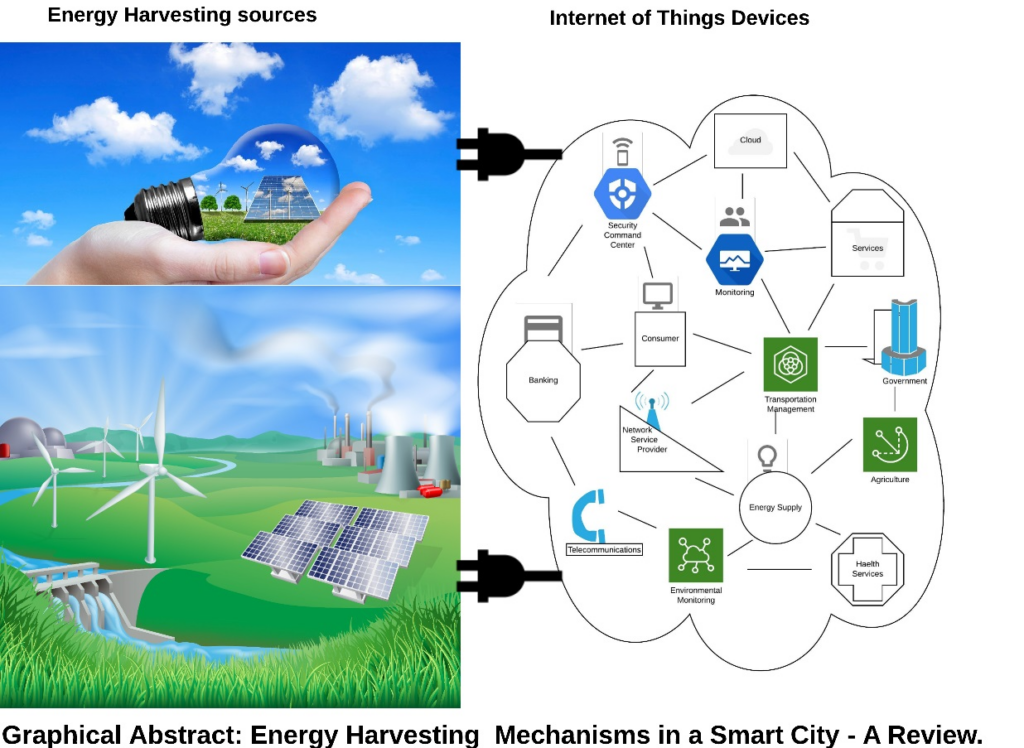ENERGY HARVESTING :
INTRODUCTION:
Energy harvesting technology is the process of collecting energy from the environment and converting it into electricity. It’s also known as power harvesting or energy scavenging.
How it works
- Energy harvesting systems capture energy from the environment, such as light, heat, vibrations, and radio waves.
- The energy is then converted into electricity to power small devices.
- The electricity is stored in a capacitor, super capacitor, or battery.
Benefits
- Energy harvesting allows devices to operate without the need for conventional power sources.
- It eliminates the need to run wires or replace batteries frequently.
- It’s especially useful for devices installed in difficult to reach places.
Examples of energy harvesting
- Photovoltaic cells: Capture light
- Piezoelectric elements: Capture vibration or pressure
- Thermo-electric generators: Capture temperature differentials
- Antennas: Capture radio energy
- Cells that extract energy from blood sugar: Capture biochemically produced energy
Applications
Energy harvesting is used in wireless devices, mobile handsets, and other small devices.
PROS AND CONS OF ENERGY HARVESTING:
Energy harvesting offers advantages like being environmentally friendly, providing power in remote locations where traditional power sources are unavailable, and requiring minimal maintenance, but its main drawbacks include low power output, dependence on environmental conditions, and potentially high upfront costs for implementation depending on the technology used.
Pros of Energy Harvesting:
- Sustainability: Harvests energy from natural sources like sunlight, vibration, or heat, contributing to a reduced carbon footprint and reliance on fossil fuels.
- Self-powered devices: Enables operation of small electronic devices without the need for batteries, which can be difficult to replace in remote locations.
- Wide range of applications: Can be used in various environments, including medical implants, wearables, sensors in remote monitoring systems, and infrastructure monitoring.
- Low maintenance: Once installed, energy harvesting systems typically require minimal maintenance.
- Potential for grid integration: With technological advancements, energy harvesting could potentially contribute to larger power grids in the future.
Cons of Energy Harvesting:
- Low power output: Most energy harvesting technologies currently generate relatively small amounts of power, limiting their use to low-power applications.
- Intermittency: Power generation can fluctuate depending on environmental conditions like sunlight availability or vibration levels.
- High initial cost: Depending on the technology, the upfront cost of installing an energy harvesting system can be significant.
- Technology limitations: energy harvesting technologies may not be efficient enough for high-power applications.
- Environmental concerns: Some energy harvesting methods, like large-scale wind farms, can have potential environmental impacts on wildlife.

KEY TECHNOLOGIES:
Energy harvesting offers advantages like providing a sustainable, environmentally friendly power source for low-power devices in remote locations by utilizing ambient energy, but its disadvantages include low power output, dependence on environmental conditions, and potentially high initial costs for implementation.
Advantages of Energy Harvesting:
- Sustainability: Harnesses renewable energy sources like sunlight, vibration, and heat, reducing reliance on fossil fuels and minimizing environmental impact.
- Self-powered devices: Enables operation of small electronic devices without the need for batteries or external power sources, ideal for remote sensing applications.
- Wide range of sources: Can be implemented using various energy sources like solar, wind, thermal, piezoelectric (vibration), and kinetic energy depending on the environment.
- Low maintenance: Once installed, energy harvesting devices often require minimal maintenance compared to traditional power sources.
- Potential for miniaturization: Can be integrated into small, compact devices due to advancements in microelectronics.
Disadvantages of Energy Harvesting:
- Low power output: Typically generates only small amounts of electricity, limiting its use to low-power applications.
- Intermittency: Power output can fluctuate significantly depending on environmental conditions like weather or vibration levels.
- High initial cost: Developing and implementing energy harvesting systems can be expensive compared to traditional power sources.
- Energy conversion efficiency: Conversion of ambient energy into usable electricity is often low, impacting overall system efficiency.
- Design complexity: Designing efficient energy harvesting devices requires specialized knowledge and can be challenging.
- Storage limitations: May require additional energy storage mechanisms to handle fluctuations in power generation.

USES:
Energy harvesting is used to capture and convert ambient energy sources like vibrations, light, heat, or radio waves into usable electrical power, primarily for powering small electronic devices in remote locations where traditional power sources are not available, including applications like: wireless sensor networks, wearable electronics, medical implants, structural health monitoring, environmental monitoring, and autonomous vehicles; essentially anywhere where a constant, wired power source is impractical or impossible to provide.
Key benefits of energy harvesting:
- Sustainability: Reduces reliance on fossil fuels by utilizing readily available ambient energy sources.
- Reduced environmental impact: Minimizes carbon emissions by utilizing renewable energy sources.
- Extended device lifespan: Eliminates the need for frequent battery replacements in remote devices.
- Autonomous operation: Enables devices to function without requiring external power sources.
Specific applications of energy harvesting technologies:
- Vibration energy harvesting: Used in industrial machinery to convert mechanical vibrations into electricity, powering sensors or data loggers.
- Solar energy harvesting (photovoltaics): Converting sunlight into electricity for powering small electronics like calculators or street lights.
- Thermoelectric energy harvesting: Generating electricity from temperature differences, potentially used in waste heat recovery systems.
- Piezoelectric energy harvesting: Converting mechanical stress into electricity, seen in applications like shoe inserts that generate power from footsteps.
- Electromagnetic energy harvesting: Capturing energy from electromagnetic waves, like radio signals, for powering wireless devices.


